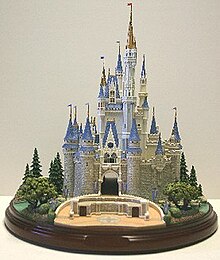Since we are selling an Olszewski Goebel Miniatures Nativity Set, I thought you might be interested in reading about the artist, Robert “Bob” Olszewski, and how he got into Miniaturization. This material was copied from Wikipedia.
Early Miniaturization
In 1972, one of Olszewski’s paintings was stolen from an exhibition in Las Vegas. When the police asked Robert to provide a photograph of the original painting, he reproduced it from memory as a 3” x 3” miniature and mailed the reproduction to the police. This event prompted Robert to use miniaturization as a teaching tool in his art classroom.
In 1975, Olszewski began his first miniatures project – a dollhouse for his two-year-old daughter in 1 : 12th scale. After a neighbor expressed interest in the dollhouse, Robert copied this design and eventually sold three more dollhouses.
After speaking with a dentist friend about carving teeth out of wax, Olszewski realized he could use the same method for figurines. In 1977, Olszewski carved his first in-scale miniature figurine to place on one of the dollhouse’s bookcases. Thus, he began using the “lost wax” casting method, which involves carving a piece of wax, casting it, and creating a mold.[5] Using a nail, a screwdriver, and his wax casting method, Robert created “Lady with an Urn,” his first professional figurine.
Using the lost wax method, Olszewski was able to reproduce his original figurines and sell them at miniature shows and conventions. Within a year, he became popular and profitable enough to leave his teaching job in 1978 to become a full-time artist.[4] He set up a “studio” in his bedroom closet to carve and paint cast bronze miniatures. Here, Robert created and produced himself 14 different figurines and about 4,000 hand-painted replicas from 1977-1978.
Goebel Miniatures, 1980-1994
Among Olszewski’s best-selling early miniatures were his reproductions of Goebel’s Hummels and Royal Doulton figurines. He produced miniature replicas of the following Hummel figurines in gold: “Barnyard Here,” “Stormy Weather,” “Kiss Me,” “Ring Around the Rosie,” and “Ride into Christmas.” He also created gold bracelet charms with the above miniatures. Today, these unauthorized Goebel figurines and bracelets command very high prices in collector markets.
After another artist warned him that he might be violating a trademark, Robert wrote to both companies to explain his work and ask if they wanted him to stop producing their figurines in miniature form. In reply, he received a contract from Royal Doulton licensing him to reproduce their figurines in miniature form. From Goebel, he received a request to see his “factory.”
Goebel’s North American representatives met with Olszewski at his home in Camarillo, California in 1979. The visit is described by Dick Hunt, author of The Goebel Miniatures of Robert Olszewski, as follows:
So [Olszewski escorted the executives] off into his bedroom and ‘the closet.’ Bob pointed out his carving department (the top of the work area), his research department (four books on the upper shelf), and the storage area for his supply of wax and bronze (top drawer of the dresser). His paints and the brushes in the second drawer made up the painting department, while the bottom drawer contained the warehouse, shipping, and receiving departments. Truly a miniature operation![10]
In July, 1979, Goebel offered Olszewski a contract as “Master Artist.”[9] The result was Goebel Miniatures Studios, founded in Camarillo, California with Olszewski in charge of design, production, and quality control.
Goebel Miniatures moved out of Robert’s bedroom closet and into a building in downtown Camarillo. From 1980 to 1994, Olszewski trained sculptors and artists for Goebel Miniatures, and worked with them to create miniature, bronze figurines, and environmental displays. As the master artist, Olszewski produced the master design for each figurine by carving the original wax design for use in the lost wax process to produce a bronze figurine. Next, each piece was hand-painted by Olszewski and given to the Studios’ artisans to reproduce from his original. Olszewski inspected all figurines produced by the other Goebel Miniatures artists before shipment.[11] All of the figurative art Olszewski produced for Goebel Miniatures was cast in bronze and individually hand-painted. The displays were cast in resin.
Olszewski went from creating unauthorized Hummel figurines to overseeing the only studio outside of Bavaria that was authorized to produce M.I. Hummel figurines.[12] Of note is the Kinder Way collection, a collection of Bavarian buildings and settings to accompany the M.I. Hummel miniatures. Goebel Miniatures produced 26 different scaled down M.I. Hummel figurines before the series was suspended in 1992, with special editions produced at later dates. The five Kinder Way buildings and displays are “Market Square Flower Stand,” “Countryside School,” “Wayside Shrine,” “Bavarian Cottage,” and “Bavarian Village.”
In 1985, Grolier commissioned Goebel Miniatures to produce the Walt Disney Snow White and Seven Dwarfs Collection to celebrate the 50th anniversary of the animated film. This collection consisted of eight individual figurine pieces, cast in bronze and hand-painted.[14] The collection met with success, and Goebel secured its own license for reproducing Walt Disney characters in miniature. While at Goebel Miniatures, Olszewski created figurines of the characters and environmental displays for Disney classic films, including Snow White and the Seven Dwarfs, Peter Pan, Pinocchio, Cinderella, and Fantasia. These figurines were sold under the name “Marquee Classics.”
More information can be found in Wikipedia.
